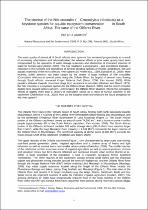 ResearchSpace
ResearchSpace
Demise of the Nile crocodile (Crocodylus niloticus) as a keystone species for aquatic ecosystem conservation in South Africa: the case of the Olifants River
JavaScript is disabled for your browser. Some features of this site may not work without it.
- ResearchSpace
- →
- Research Publications/Outputs
- →
- Journal Articles
- →
- View Item
| dc.contributor.author |
Ashton, PJ

|
|
| dc.date.accessioned | 2010-07-22T11:13:07Z | |
| dc.date.available | 2010-07-22T11:13:07Z | |
| dc.date.issued | 2010-06 | |
| dc.identifier.citation | Ashton, PJ. Demise of the Nile crocodile (Crocodylus niloticus) as a keystone species for aquatic ecosystem conservation in South Africa: the case of the Olifants River. Aquatic Conservation: Marine and Freshwater Ecosystems, Vol 20(5), pp 489–493 | en |
| dc.identifier.issn | 1052-7613 | |
| dc.identifier.uri | http://www3.interscience.wiley.com/cgi-bin/fulltext/123566016/PDFSTART | |
| dc.identifier.uri | http://hdl.handle.net/10204/4121 | |
| dc.description | Copyright: 2010 Wiley-Blackwell. This is a preprint of an article whose final form has been published in the Aquatic Conservation: Marine and Freshwater Ecosystems Journal, Vol 20(5), pp 489–493, available at http://www3.interscience.wiley.com/cgi-bin/fulltext/123566016/PDFSTART | en |
| dc.description.abstract | The water quality of almost all of South Africa’s river systems has worsened progressively as a result of increasing urbanization and industrialization; the adverse effects of poor water quality have been compounded by the operation of water storage reservoirs and abstraction of increased volumes of water for human uses (Ashton, 2007). This has resulted in a progressive – and sometimes dramatic – reduction in the numbers and abundance of several sensitive species of insects, amphibians, fish and aquatic mammals in the worst affected river systems (O’Keeffe et al., 1989; Darwall et al. 2009). More recently, public attention has been caught by the deaths of large numbers of Nile crocodiles (Crocodylus niloticus) at several points along the Olifants River, the largest of several rivers flowing through South Africa’s renowned Kruger National Park (Steyn, 2008; Van Vuuren, 2009). While people’s attitudes towards crocodiles range from reverence to revulsion (Graham and Beard, 1973), the Nile crocodile is a keystone species for the Olifants River (Joubert, 2007) and the recent crocodile deaths have caused serious concern. Unfortunately, the Olifants River situation reflects the cumulative effects of slightly more than a century of ecosystem stress as a result of human activities in the catchment (Oberholster et al., 2010). How did the situation arise and what are the future prospects for this river system? | en |
| dc.language.iso | en | en |
| dc.publisher | Wiley-Blackwell | en |
| dc.subject | Aquatic conservation | en |
| dc.subject | Marine ecosystems | en |
| dc.subject | Freshwater ecosystems | en |
| dc.subject | Nile crocodiles | en |
| dc.subject | Olifants River | en |
| dc.subject | River systems | en |
| dc.title | Demise of the Nile crocodile (Crocodylus niloticus) as a keystone species for aquatic ecosystem conservation in South Africa: the case of the Olifants River | en |
| dc.type | Article | en |
| dc.identifier.apacitation | Ashton, P. (2010). Demise of the Nile crocodile (Crocodylus niloticus) as a keystone species for aquatic ecosystem conservation in South Africa: the case of the Olifants River. http://hdl.handle.net/10204/4121 | en_ZA |
| dc.identifier.chicagocitation | Ashton, PJ "Demise of the Nile crocodile (Crocodylus niloticus) as a keystone species for aquatic ecosystem conservation in South Africa: the case of the Olifants River." (2010) http://hdl.handle.net/10204/4121 | en_ZA |
| dc.identifier.vancouvercitation | Ashton P. Demise of the Nile crocodile (Crocodylus niloticus) as a keystone species for aquatic ecosystem conservation in South Africa: the case of the Olifants River. 2010; http://hdl.handle.net/10204/4121. | en_ZA |
| dc.identifier.ris | TY - Article AU - Ashton, PJ AB - The water quality of almost all of South Africa’s river systems has worsened progressively as a result of increasing urbanization and industrialization; the adverse effects of poor water quality have been compounded by the operation of water storage reservoirs and abstraction of increased volumes of water for human uses (Ashton, 2007). This has resulted in a progressive – and sometimes dramatic – reduction in the numbers and abundance of several sensitive species of insects, amphibians, fish and aquatic mammals in the worst affected river systems (O’Keeffe et al., 1989; Darwall et al. 2009). More recently, public attention has been caught by the deaths of large numbers of Nile crocodiles (Crocodylus niloticus) at several points along the Olifants River, the largest of several rivers flowing through South Africa’s renowned Kruger National Park (Steyn, 2008; Van Vuuren, 2009). While people’s attitudes towards crocodiles range from reverence to revulsion (Graham and Beard, 1973), the Nile crocodile is a keystone species for the Olifants River (Joubert, 2007) and the recent crocodile deaths have caused serious concern. Unfortunately, the Olifants River situation reflects the cumulative effects of slightly more than a century of ecosystem stress as a result of human activities in the catchment (Oberholster et al., 2010). How did the situation arise and what are the future prospects for this river system? DA - 2010-06 DB - ResearchSpace DP - CSIR KW - Aquatic conservation KW - Marine ecosystems KW - Freshwater ecosystems KW - Nile crocodiles KW - Olifants River KW - River systems LK - https://researchspace.csir.co.za PY - 2010 SM - 1052-7613 T1 - Demise of the Nile crocodile (Crocodylus niloticus) as a keystone species for aquatic ecosystem conservation in South Africa: the case of the Olifants River TI - Demise of the Nile crocodile (Crocodylus niloticus) as a keystone species for aquatic ecosystem conservation in South Africa: the case of the Olifants River UR - http://hdl.handle.net/10204/4121 ER - | en_ZA |





